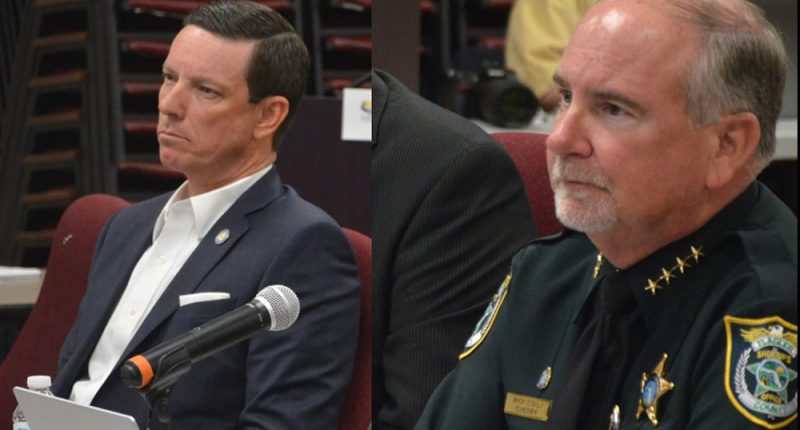
the Flagler County Commission must close a $2.9 million deficit as it prepares a $150 million 2026 budget that goes in effect on Oct. 1.
The county and its five constitutional officers are projecting a 10.7 percent growth in their collective budgets, from $137.2 million this year to a requested $151.9 million. Projected revenue will grow by 9.6 percent, or $11.8 million. But that is not enough to fully cover the gap. Commission Chair Andy Dance played a little dodgeball with “Doge” and its constitutional officers, but didn’t get far.
“We had a priority at the beginning of budget season to build a budget based on flat or lower millage,” Dance said, referring to the property tax. “So as each of you come up here, we’ve got work to do.”
Each of the five constitutional officers presented their budgets to the commission at an afternoon workshop today–the clerk of court, the tax collector, the supervisor of elections, the property appraiser and the sheriff. The sixth entity is county government itself. Commissioners asked each constitutional officer to work cooperatively to help close the deficit, which–relatively to previous years, and relative to the size of the budget, is not as large as it has been in some previous years, entering budget season.
The clerk of court is projecting a nearly 32 percent budget increase (a $1.1 million increase out of a total budget of $4.6 million), driven in part by sharply increasing operating expenses and personnel costs. The clerk is asking to increase starting pay to $20 an hour to be competitive with similar agencies, to add five employees to its 62, and to buttress its retirement fund. “There is absolutely zero fat, not one dime in this budget,” Clerk of Court Tom Bexley told the commissioners.
In comparison, the property appraiser and the supervisor of elections are projecting much smaller increases–less than 1 percent for the supervisor, 7 percent for the property appraiser, out of a budget of $3.9 million. The tax collector is projecting a 10 percent increase, the Sheriff’s Office a 13.6 percent increase, and the County Commission (or county government) an $8.6 percent increase.
All of these budgets are drawn from the general fund, the fund substantially supported by property taxes, and therefore the fund that dictates the property taxes residents and businesses pay.
Dance said the county will be part of state government’s so-called “doge review process,” the state version of the federal Department of Government Efficiency, which has been tasked with sharply cutting government budgets. “As I understand, the constitutionals have elected not to join us on that,” Dance said. “It’s voluntary, I fully understand. But if we’re not going to work together in that team atmosphere, then how do we be able to approach our public with that same team mentality?”
“The ‘Doge’ letter that came to the county was addressed to the county,” Bexley said. “We all talk to our associations, and frankly, it wasn’t directed to us. I don’t feel like there’s going to be a movement where they want to scrutinize constitutional officers. I could be wrong. At this time, we’re not going to provide the information because we weren’t specifically asked for it. Should that time come, first guy in line, absolutely.”
Bexley, the clerk of court, said investment income alone could close whatever gap there is in his budget: “Excess proceeds currently invested in the open market are in excess of $200 million right now,” he said. “That is a lot of cash. Over the past three years, our average interest on income and on investments is better than $5 million annually. This increase in revenue would easily cover the increases needed for my needs-based budget I’m proposing today.”
Dance told him there was no specific ask from the state regarding government efficiency, and in fact the state’s letter was vague and its processes vaguer. The county was volunteering “as part of our internal efficiency process,” he said, noting that every constitutional officer is basing his and her budgets on needs, with similar challenges. He didn’t provide examples, but County Administrator Heidi Petito, with the commission’s support, plans to reevaluate the county’s Department of Health and Human Services.
Sheriff Rick Staly echoed some of Bexley’s response about “doge,” and said he saw the need for it federally, but that Florida was different. He said constitutional officers are independent. “I don’t think doge in Florida will be successful unless they also talk to people, because if they’re just looking at spreadsheets, that doesn’t tell you the whole story,” the sheriff said.
The county draws the largest portion of the funds, with a projected $83.4 million. The Sheriff’s Office is next, at $52 million. In comparison, all four other constitutional officers have a combined budget of $16.4 million.
The sheriff’s budget would increase from $45.7 million to $52 million, or $6.2 million, with 375 employees, with a relatively low 7 percent turnover rate and a waiting list for employees to join the agency. The sheriff is projecting the addition of three deputies in next year’s budget, as far as the county is concerned (with an additional nine to be paid for by Palm Coast government).
“We continue to have historic crime reduction, despite our population increasing. Our trends so far in 2025 is down,” the sheriff said, though he noted that statistical comparisons with previous years have changed since the federal government changed its accounting system.
Staly raised some structural issues he considers inefficient and not in line with state recommendations: the county owns the 911 dispatch center, the radios, and the CAD system–computer assisted dispatching, which enables the 911 system, the road deputies, the firefighters on the street to all be on the same incident page through their computers while keeping up with all other incidents in real time. The sheriff staffs the 911 system and uses the equipment.
“If one of those entities, one of those pieces go down, your fire chief is responsible for the 911 system and non-emergency phone lines, your IT department is responsible for the CAD and the the RMS system, and your emergency management is responsible for the radio system,” Staly said. “So we’re having to call three different internal units if there’s an issue, because we don’t control any of that for the repairs and those things do go down.” 9One option, he said, was to turn over the whole system, employees included, to the county.)
Staly was also displeased with county plan to use the Alachua 911 system as backup for Flagler County, in case of a local failure, because he wasn’t consulted about aspects of the plan. He was equally displeased with a county billing increase for CAD that was close to slipping through county approval without discussion.
Another increase: Radio user fees. “Until it got really high, I didn’t really look at it that much to be candid with you, so this next fiscal year it’s a $266,937 increase,” he said. In 2022-23, the entire fee for radios was $285,304. The proposed fee for next year is over $1 million, a 265 percent increase. The CAD system is also increasing similarly. “This hit so high on the CAD that I have my staff looking right now on what it will cost me to do an independent CAD,” Staly said. “I can’t afford this. The taxpayers can’t afford this. And actually, we have already found one.”
The message from the sheriff of course was that the county should be rethinking its requests for cuts to the sheriff’s budget, when budget cuts could be achieved through the county’s vendors. He proposed alternatives, including a different radio system.
Commissioners had questions about funding principles and formulas, among other questions, but did not challenge any single aspect of the sheriff’s presentation. “We’ve got a 3 million hole to fill, so I just want to keep the communications open as we work through this process and try to get to the finish line,” Dance said.
When commissioners discussed the budgets among themselves, Commissioner Kim Carney questioned the customary cost-of-living, or inflation, increases. “There’s no doubt in my mind that our county needs to be moving towards something that’s a little bit more efficient than just awarding everybody 4 percent,” she said, though Dance corrected her to the extent that state guidelines set the rough parameters of inflation increases, even though they’re not a guarantee. The budget gap, Carney said, “is going to be a huge fight.”










